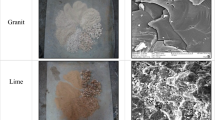Abstract
Backscattered electron images (BSE) obtained by scanning electron microscope was used to quantitatively characterize the microstructure of interfacial transition zone (ITZ) in concrete. Influences of aggregate size (5, 10, 20, and 30 mm), water to cement ratio (0.23, 0.35 and 0.53) and curing time (from 3d to 90d) on the microstructure of interfacial transition zone between coarse aggregate and bulk cement matrix were investigated. The volume percentage of detectable porosity and unhydrated cement in ITZ was quantitatively analyzed and compared with that in the matrix of various concretes. Nanoindentation technology was applied to obtain the elastic properties of ITZ and matrix, and the elastic modulus of concrete was then calculated based on the Lu & Torquato model and self-consistence scheme by using the ITZ thickness and elastic modulus obtained from this investigation. The experimental results demonstrated that the microstructure and thickness of ITZ in concrete vary with a variety of factors, like aggregate size, water to cement ratio and curing time. The relative low elastic properties of ITZ should be paid attention to, especially for early age concrete.
Similar content being viewed by others
References
Scrivener KL, Bentur A, Pratt PL. Quantitative Characterization of the Transition Zone in High Strength Concretes[J]. Advances in Cement Research, 1988, 1(4): 230–237
Monteiro PJM, Maso JC, Ollivier JP. The Aggregate-mortar Inter-Face[J]. Cement and Concrete Research, 1985, 15(6): 953–958
Kjellsen KO, Wallevik OH, Fjällberg L. Microstructure and Microchemistry of the Paste-aggregate Interfacial Transition zone of High-performance Concrete[J]. Advances in Cement Research, 1998, 10(1): 33–40
Bentur A, Alexander MG. A Review of the Work of the RILEM TC 159-ETC: Engineering of the Interfacial Transition Zone in Cementitious Composites[J]. Materials and Structures, 2000, 33(2): 82–87
Scrivener KL, Crumbie AK, Laugesen P. The Interfacial Transition Zone (ITZ) between Cement Paste and Aggregate in Concrete[J]. Interface Science, 2004, 12(4): 411–421
Diamond S. Considerations in Image Analysis as Applied to Investigations of the ITZ in Concrete[J]. Cement and Concrete Composites, 2001, 23(2): 171–178
Diamond S, Huang J. The ITZ in Concrete-A Different View based on Image Analysis and SEM Observations[J]. Cement and Concrete Composites, 2001, 23(2): 179–188
Scrivener KL. Microstructure of Concrete[J]. Materials Science of Concrete III, I, 1, 1989: 127
Grondin F, Bouasker M, Mounanga P, et al. Physico-chemical Deformations of Solidifying Cementitious Systems: Multiscale Modelling[J]. Materials and Structures, 2010, 43(1-2): 151–165
Sorelli L, Constantinides G, Ulm F J, et al. The Nano-mechanical Signature of Ultra High Performance Concrete by Statistical Nanoindentation Techniques[J]. Cement and Concrete Research, 2008, 38(12): 1447–1456
Jiang L, Zhang Y, Hu C, et al. Calculation of Elastic Modulus of Earlyage Cement Paste[J]. Advances in Cement Research, 2012, 24(4): 193–201
Garboczi EJ, Bentz DP. Analytical Formulas for Interfacial Transition Zone Properties[J]. Advanced Cement Based Materials, 1997, 6(3): 99–108
Lu B, Torquato S. Nearest-surface Distribution Functions for Polydispersed Particle Systems[J]. Physical Review A, 1992, 45(8): 5530
Oliver WC, Pharr GM. An improved Technique for Determining Hardness and Elastic Modulus Using Load and Displacement Sensing Indentation Experiments[J]. Journal of Materials Research, 1992, 7(06): 1564–1583
Oliver WC, Pharr GM. Measurement of Hardness and Elastic Modulus by Instrumented Indentation: Advances in Understanding and Refinements to Methodology[J]. Journal of Materials Research, 2004, 19(1): 3–20
Mitsui K, Li Z, Lang D, et al. Relationship between Microstructure and Mechanical Properties of The Paste-Aggregate Interface[J]. Aci Materials Journal, 1994
Jennings HM, Thomas JJ, Gevrenov JS, et al. A multi-technique Investigation of the Nanoporosity of Cement Paste[J]. Cement & Concrete Research, 2007, 37(3): 329–336
Mondal P, Shah SP, Marks L. A Reliable Technique to Determine the Local Mechanical Properties at the Nanoscale for Cementitious Materials[J]. Cement & Concrete Research, 2007, 37(10): 1440–1444
Constantinides G, Ulm FJ. The Effect of Two Types of C-S-H on the Elasticity of Cement-based Materials: Results from Nanoindentation and Micromechanical Modeling[J]. Cement & Concrete Research, 2004, 34(1): 67–80
Haha MB, Weerdt KD, Lothenbach B. Quantification of the Degree of Reaction of Fly Ash[J]. Cement & Concrete Research, 2010, 40(11): 1620–1629
Xiao J, Li W, Sun Z, et al. Properties of Interfacial Transition Zones in Recycled Aggregate Concrete Tested by Nanoindentation[J]. Cement & Concrete Composites, 2013, 37(3): 276–292
Ramesh G, Sotelino ED, Chen WF. Effect of Transition Zone on Elastic Moduli of Concrete Materials[J]. Cement & Concrete Research, 1996, 26(4): 611–622
Mondal P, Shah SP, Marks LD. Nanoscale Characterization of Cementitious Materials[J]. Aci Materials Journal, 2008, 105(2):174–179
Elsharief A, Cohen MD, Olek J. Influence of Aggregate Size, Water Cement Ratio and Age on the Microstructure of the Interfacial Transition Zone[J]. Cement & Concrete Research, 2003, 33(11): 1837–1849
Scrivener KL. Backscattered Electron Imaging of Cementitious Microstructures: Understanding and Quantification[J]. Cement & Concrete Composites, 2004, 26(8): 935–945
Wong HS, Head MK, Buenfeld NR. Pore segmentation of Cement-based Materials from Backscattered Electron Images[J]. Cement & Concrete Research, 2006, 36(6): 1083–1090
Gao Y, Schutter GD, Ye G, et al. The ITZ Microstructure, Thickness and Porosity in Blended Cementitious Composite: Effects of Curing Age, Water to Binder ratio and Aggregate Content[J]. Composites Part B, Engineering, 2014, 60(4): 1–13
Erdem S, Dawson AR, Thom NH. Influence of the Micro-and Nanoscale Local Mechanical Properties of the Interfacial Transition Zone on Impact Behavior of Concrete Made with Different Aggregates[J]. Cement & Concrete Research, 2012, 42(2): 447–458
Author information
Authors and Affiliations
Corresponding author
Additional information
Funded by the National Natural Science Foundation of China (No. 51178105), the Major State Basic Research Development Program of China(973 Program) (No. 2015CB655104) and the Collaborative Innovation Centre for Advanced Civil Engineering Materials
Rights and permissions
About this article
Cite this article
Jia, Z., Han, Y., Zhang, Y. et al. Quantitative characterization and elastic properties of interfacial transition zone around coarse aggregate in concrete. J. Wuhan Univ. Technol.-Mat. Sci. Edit. 32, 838–844 (2017). https://doi.org/10.1007/s11595-017-1677-8
Received:
Accepted:
Published:
Issue Date:
DOI: https://doi.org/10.1007/s11595-017-1677-8




